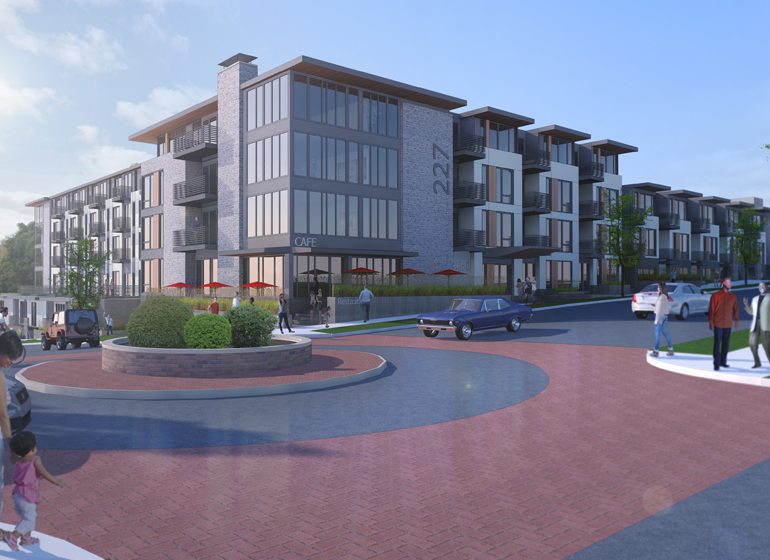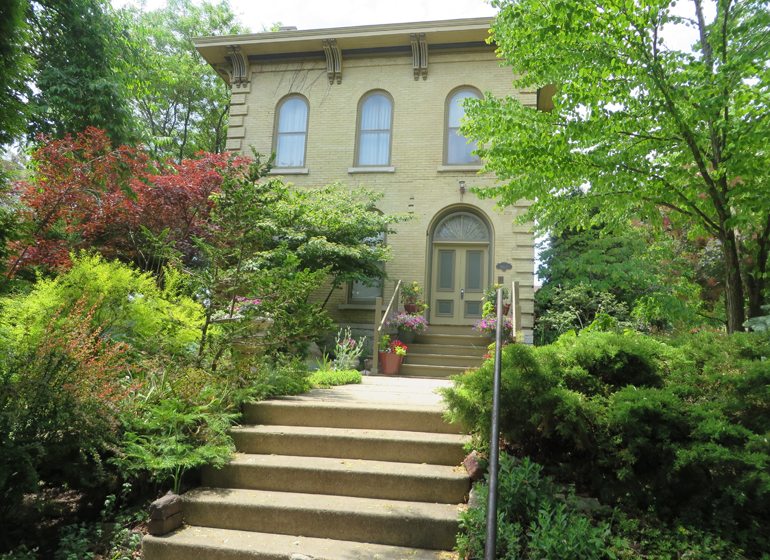On May 20, Kevin Newell, president of Glendale-based Royal Capital Group LLC, hosted a cookout for about 50 people in Milwaukee’s Brewers Hill neighborhood.
Newell, 31, is proposing one of the largest developments Brewers Hill, one of the city’s oldest neighborhoods, has seen in quite a while, and he wanted to make sure the neighbors had a chance to see renderings before they were revealed publicly the following week.

“These parcels were set up for condos in 2004, but the market started showing itself and the plan was tabled,” Newell said. “The owner put the land on the market in 2011, a couple of groups looked at it, and we were able to slip in last summer. Some folks are excited; (but) others would rather have it be a $2 million dog park.”
The $32 million development, to be called The Hills Luxury Commons, includes a 97-unit, four-story building with a restaurant/cafe on the street level at the southwest corner of North Hubbard Street and East Reservoir Avenue.
Two other buildings totaling 84 apartments will also be developed at the southwest corner of North Hubbard and East Brown streets.
Newell is buying the land from Paul Marks, principal at Chicago-based Brewers Hill Commons II LLC, who spent the early 2000s developing a portion of Brewers Hill under the company name Tandem Development LLC.
Between 2000 and 2005, Marks and former partner Paul Dincin developed a two-building condominium complex on the north side of Reservoir Avenue between Palmer Street and Killian Place that included a 56-unit building called Cobblers Lofts and a 64-unit building called Shoeworks Lofts.
The buildings were formerly owned by Milwaukee shoemaker Weyco Group. Tandem Development also built about a dozen single family homes on property purchased from the city along Brown Street in Brewers Hill.

By 2010, the condominium market in Milwaukee was saturated and the economy was in recession, so Marks pulled out of Milwaukee.
“Our primary focus is selling condos to first-time home buyers and we didn’t want to change that,” Marks said. “So we sought out a developer to purchase our land with a different plan. I think Royal Capital has a great business plan for the neighborhood.”
Newell, who has led several developments in Madison, was attracted to Brewers Hill because of the diversity, which he believes rivals any multicultural environment in the country.
“It’s not only different races and cultures, but you’ve got doctors and lawyers and folks who work in food service living side by side,” Newell said. “It adds a different level of quality that most neighborhoods can’t offer.”
The Department of City Development and the Historic Brewers Hill Association have endorsed Newell’s plan. The project is currently working its way through the Common Council committees. It received preliminary Plan Commission approval on June 13.
Bounded by Pleasant Street to the south, North Avenue to the north, King Drive to the West and Holton and Hubbard streets to the east, Brewers Hill is a diverse pocket neighborhood nestled between Haymarket and the East Side.

Located within walking distance of downtown Milwaukee and on the bluffs overlooking the Milwaukee River valley, Brewers Hill received a lot of attention in the late 1990s but then development there slowed down as developers looked to other areas of the city, including the Historic Third Ward and Walker’s Point.
Molly Booth, secretary at the Historic Brewers Hill Association, said it is refreshing to see renewed interest in development of the neighborhood. Yet even without the new development interest, Brewers Hill has continually attracted people seeking an urban lifestyle, historic homes and a diverse community.
“The neighborhood doesn’t necessarily need to evolve, but there are one or two larger tracts of vacant buildings and land that need to be redeveloped,” Booth said, adding the association wants to be sure any new development is cohesive with the existing single-family and two-family residential properties.
Rocky Marcoux, commissioner for the Department of City Development, said one of the issues with Brewers Hill over the past 20 years has been the historic homes became too expensive to maintain for some of the longtime residents of the neighborhood.
“You look at Brewers Hill and call it gentrification, but you look at the Third Ward and call it improvement,” Marcoux said. “The big difference is, the Third Ward didn’t have a lot of people living there originally who were impacted.”
After seeing how people were affected in Brewers Hill, Marcoux said the city and Alderwoman Milele Coggs are being careful with their Bronzeville initiative to make sure not to send a message—either verbally or with the projects they choose to support—that they are trying to move poor people out of Bronzeville.
“We want to mix the income of that neighborhood, but we also want the people in Bronzeville to stay as long as they want and to prosper there,” Marcoux said.

As far as Brewers Hill, Marcoux believes this is the time for the neighborhood to flourish.
“With the Beerline (development along Commerce Street) almost complete and everything going on in the Park East, you see the movement going north and this is a good thing,” he said. “This is going to help (the) Harambee (neighborhood) and add a lot of interest to Bronzeville.”
Booth, too, hopes development momentum from the Milwaukee Bucks arena project in the Park East corridor will spread north to the surrounding residential neighborhoods and King Drive.
“King Drive has an amazing building stock and a tremendous amount of potential,” Booth said.
Juli Kaufmann, founder of Fix Development LLC, bought her first house in Brewers Hill in 1995 and lived in the neighborhood before moving to Walker’s Point in 2005, where she focused a lot of her commercial development efforts in that neighborhood, which at the time was just beginning its own resurgence.
Kaufmann said Brewers Hill has struggled with attracting services because there hasn’t been critical mass living in the area.
“It never quite turned the way you might expect some east side neighborhoods to turn,” she said. “It always had beer barons and workers living side by side, but what held it back is that is the near north side, so it doesn’t appeal to some people, suburbanites and young professionals who come from upper incomes and didn’t always want to integrate into Milwaukee’s mixed income neighborhoods.”
Developments like the one being proposed by Newell will create more density, which in turn could help King Drive, which has historically struggled economically to become a thriving main street, Kaufmann said.
“Hopefully there will finally be enough nearby residents to support that street,” Kaufmann said. “That would be transformative for Milwaukee.”
Get the latest southeastern Wisconsin commercial real estate news delivered to your inbox each Wednesday. Sign up for BizTimes’ Real Estate Weekly at biztimes.com/subscribe.

